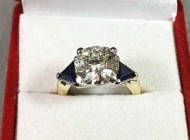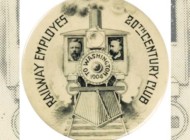.jpg)
Three days of live Americana Week sales brought together fine, folk and decorative arts. Here at the podium, John Hays, deputy chairman of Christie’s Americas, helped steer the week’s total to $15,842,862 on the combined events.
Review & Onsite Photos by Laura Beach, Photos Courtesy of Christie’s
NEW YORK CITY – For the first time in three years, the Americana faithful gathered in Manhattan the week of January 16 for a full complement of auctions paired with the Winter Show, the season’s traditional anchor. There were hugs and kisses as old friends caught sight of one another, but also an understanding that the world – reshaped by an ongoing tech revolution, an ebbing pandemic and a seismic reckoning on racial justice – has changed. At Christie’s, evidence of the transition ranged from how people buy, often online and without recourse to printed catalogs, to what they buy. Even Christie’s staging and sequencing of its sales has evolved, reflecting a more expansive view of the American arts, with fine and decorative, folk and formal, the comfortingly traditional and the formerly outré no longer segregated. When the last lot crossed the block on January 20, three days of live Americana Week sales had generated $15,842,862, including premium, on 423 lots offered, a tally much buoyed by the inclusion of fine arts.
Cara Zimmerman, head of Christie’s departments of Americana and Outsider Art, noted, “For the last few years Americana has had a sale timing that works with American paintings. What was fun this year is that one of the paintings sales, ‘From Peale to Peto: American Masters from the Pollack Collection,’ was a collaboration between our departments. We hope to collaborate more in the future. Also fun is seeing the crossover as different collectors engage with various areas of the broader marketplace. We are interested in seeing how foot traffic from one sale can affect other sales.”
Just prior to Americana Week’s start, Christie’s recorded close to 160 online registrants for “Outsider and Vernacular Art” and more than 200 registrants for “Important Americana.” Zimmerman explained, “Our directive here is to lean into the capabilities of the internet. With virtual walk-throughs, high-resolution photography, extra images when people request them and our condition reports, many potential buyers at this point feel comfortable participating in sales without attending them in person.”
.jpg)
“Fighting Hummingbirds with Pink Orchid” by Martin Johnson Heade (1819-1904), $945,000 ($400/600,000). Nineteenth Century American Art.
Outsider and Vernacular Art
Christie’s live sales began on January 18 with “Outsider and Vernacular Art.” The 103-lot session garnered $2,064,384, including premium, and saw solid prices for blue-chip artists. The sequence was 99 percent sold by both lot and value, and 132 percent over low estimate.
Only a few years ago, Winfred Rembert, who grew up in rural Georgia picking cotton and vegetables but died in Connecticut in 2021, was barely known. With the publication of his Pulitzer Prize winning autobiography, Chasing Me to My Grave: An Artist’s Memoir of the Jim Crow South, Rembert is now widely celebrated for his rhythmic compositions on dyed, tooled and carved leather. At Christie’s, his undated work “The Black Cat,” depicting a nightclub crowded with exuberant revelers, sailed past its $150/200,000 estimate to bring $302,400, with premium surpassing the previous auction record set for Rembert’s “Chain Gang Picking Cotton #4” of 2007, sold by Brunk Auctions just last September.
More understated was Bill Traylor’s graphite on repurposed card drawing “Goat, Camel, Lion and Figures,” which settled within estimate to bring $252,000. Executed around 1939 and once retailed by Ricco Maresca Gallery in New York, the historically significant study relates to a series of contemporaneous photographs made by Charles Shannon.
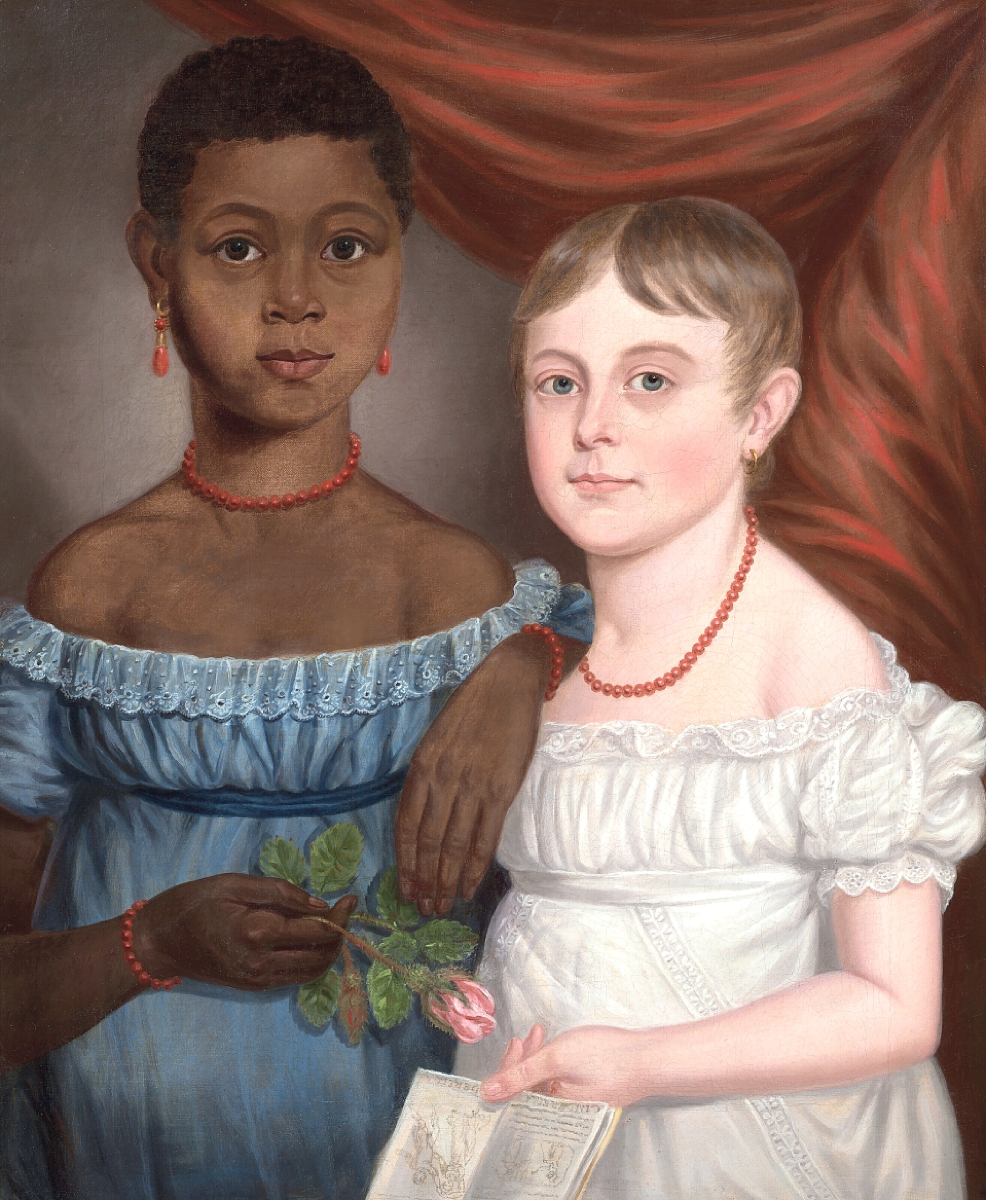
“Portrait of Two Girls,” artist unknown, early Nineteenth Century, $945,000 ($50/100,000). Sold to London dealer Philip Mould underbid by the phone. Important Americana.
Of special note were 14 paintings and mixed-media works by Thornton Dial, his brother Arthur and son Thornton Dial Jr. Consigned by actor and activist Jane Fonda, the pieces ranged from “Welfare Office” by Arthur Dial, $1,512, to a semi-abstract, viscerally textured work on canvas, $107,500, of 1991 by Thornton Dial. According to Christie’s, Fonda, a trustee of Atlanta’s Souls Grown Deep Foundation, discovered Dial and other Black artists of the American South through art historian Bill Arnett, an early champion of Dial. In all, the Fonda trove made $277,956.
Small but vivid, “Eagle Headed Blengin” by Henry Darger narrowly topped estimate to sell for $107,100. The graphite, carbon transfer and watercolor on paper of circa 1950-60 bore the provenance of the Carl Hammer Gallery of Chicago and depicts what Darger called a Blengiglomenean serpent, a fierce, eagle-like creature with a long tail.
Also of note were Sam Doyle’s comical “I’ll Hit You Man,” a large enamel painting on repurposed metal siding dating to about 1979, $45,360 ($15/30,000) and “Voice of the Third Angel,” Minnie Evans’ oil and ink on paperboard meditation on heaven and hell. The latter more than quadrupled estimate to bring $42,840.
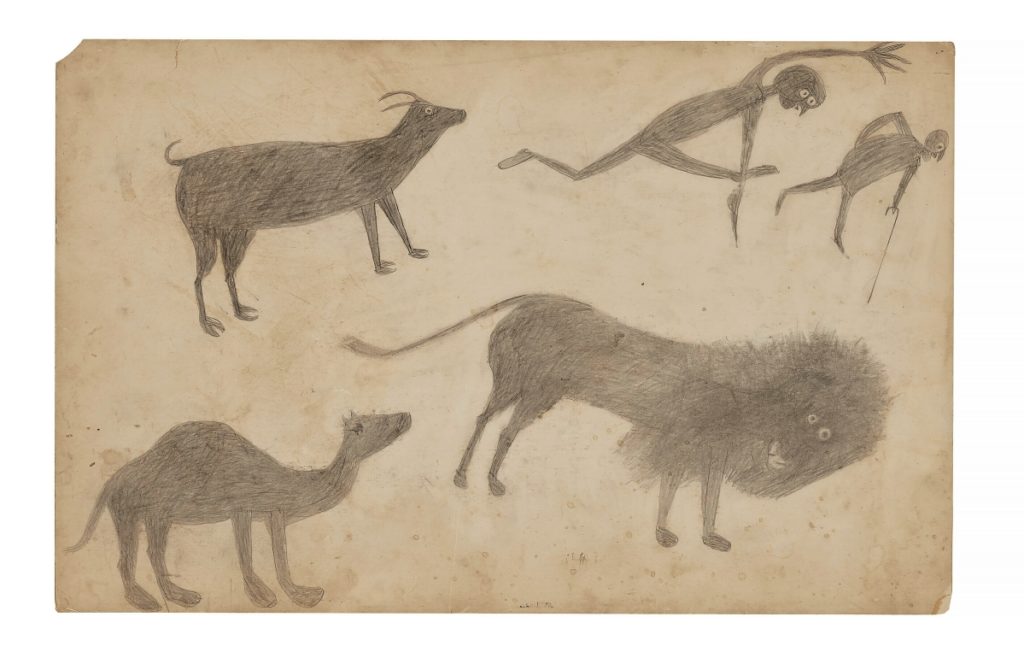
“Goat, Camel, Lion and Figures” by Bill Traylor (circa 1853-1949), $252,000 ($200/300,000). Outsider and Vernacular Art.
From Peale to Peto: American Masters from The Pollack Collection
A small but sharply focused collection of American paintings, most dating from the very late Eighteenth Century through the mid-Nineteenth Century, performed well on January 19, totaling $2,701,944 on just 34 lots. The session was 94 percent sold by lot, and 156 percent by low estimate.
Emphasizing still life, portraiture and trompe l’oeil works on panel and canvas, the paintings were assembled by trial attorney Daniel A. Pollack, who before his death in 2019 bought extensively and well, often at auction. Pollack promoted the American arts at the Harvard Art Museums, where for over a decade he chaired the institution’s American Arts Committee. In March 2022, Harvard announced its receipt of 21 pieces of Eighteenth Century American silver gathered by Pollack and his wife Susan. An Edward Winslow caudle cup associated with the First Congregational Church in Milford, Conn., studded the gift.
The Pollack session’s top five paintings were by members of the celebrated Peale family. Heading the group was “George Washington” by Charles Peale Polk, a student and ward of his uncle Charles Willson Peale. Known for his portraits of Revolutionary War heroes, Polk modeled this rendition of Washington after Peale’s bust-sized “Convention” portrait. Signed and dated 1793, the Polk work exceeded high estimate to bring $630,000 ($200/400,000). The following day, as part of its “Important Americana” session, Christie’s featured a second Washington portrait, by Gilbert Stuart. One of the artist’s so-called “Athenaeum” portraits, 85 examples of which are known, it also made $630,000 ($500/700,000).
The delectable “Currants and Biscuits” by Raphaelle Peale doubled high estimate to fetch $352,800. Signed and dated 1813, this oil on panel is a particularly handsome example by an artist known to have painted as many as 150 still lifes, of which approximately 50 survive.
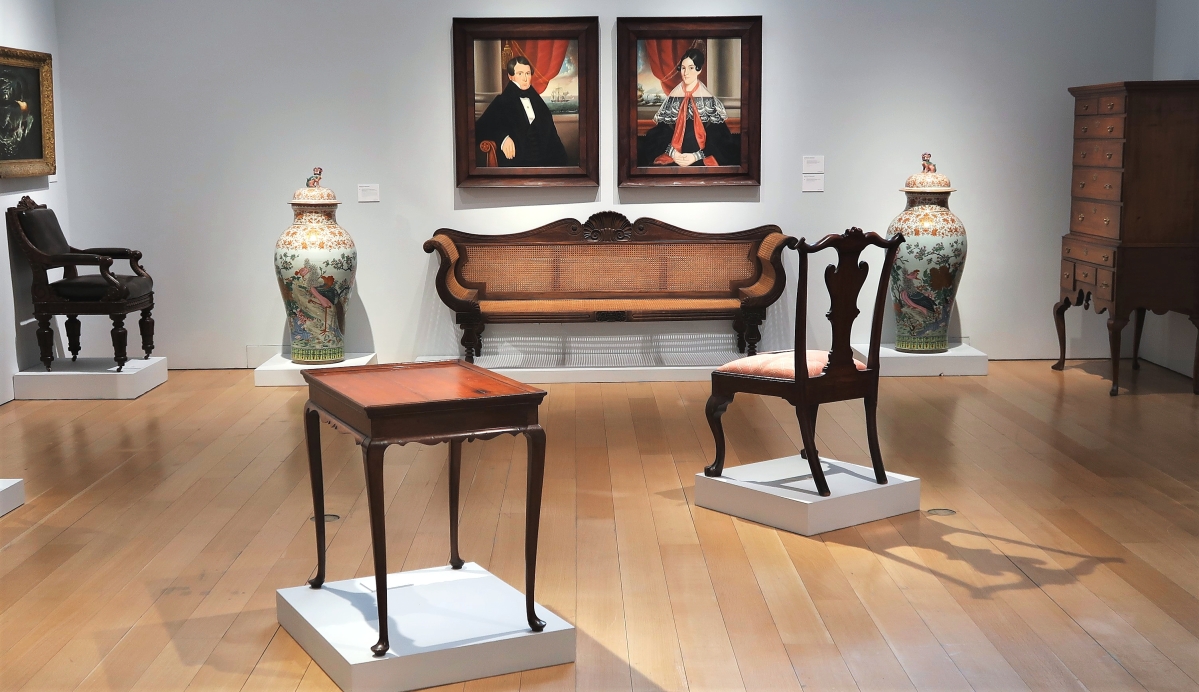
The Chinese export carved settee of circa 1830, $6,930, is surmounted by portraits, $37,800, of Captain John Manwaring and his wife Martha of New London, Conn., by Isaac Sheffield. Flanking are Chinese export Qianlong period porcelain vases, $100,800. Left, US House of Representatives chair attributed to Bembe and Kimmel, $22,680; center, Queen Anne cherrywood tray-top tea table, $5,670, and Philadelphia Chippendale mahogany side chair, $2,520; and right, Rhode Island maple Queen Anne high chest of drawers, $8,820. Important Americana.
Acquired by Pollack from the Schwarz Gallery of Philadelphia, the luscious “Watermelon” by Sarah Miriam Peale achieved a record $277,200 ($40/60,000). Painted on panel in 1822, the 13½-by-19½-inch work relates to a similar painting of the same date in the collection of the Harvard Art Museums. The artist and her sister, Anna Claypoole Peale, were the first women elected to the Pennsylvania Academy of Fine Arts, in 1824. Also setting a new record at auction for the artist was “Five Bobwhites at the Delaware Water Gap” by Titian Ramsay Peale, which auctioned for $163,800 (50/70,000).
Rounding out the Pollack session, William Michael Harnett’s winning “Lobster, Fruit, Champagne and Newspaper” of 1882 carried off a bid of $126,000 and was the top still life not by a Peale family member.
Of special note was the fascinating “Bric-a-Brac,” $151,200 ($70/100,000). Painted by George Henry Hall in 1880, the oil on canvas with touches of Aesthetic Movement imagery reflects the early stirrings of antiquarianism in the United States.
The top-selling works by John Frederick Peto were “Tabletop Still Life,” an oil on canvas that came in mid-estimate at $40,320, and the 1899 “Books and Inkwell,” $37,800.
Among marine paintings were Fitz Henry Lane’s 1846 “Mary Ann,” $81,900, and “An American Merchantman Backing Her Sails As She Heaves-to Off A Rocky Shore” by Thomas Birch, $30,240.
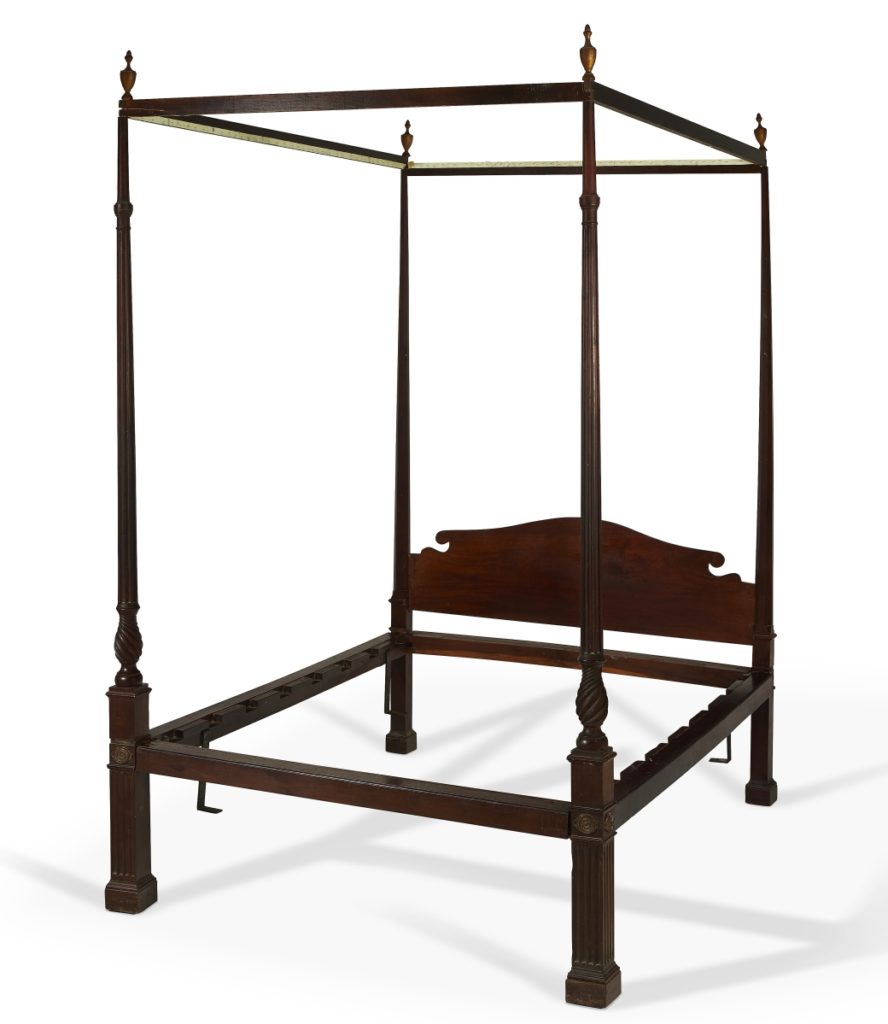
Ellery-Vernon family Chippendale carved mahogany bedstead, Newport, 1770-90, sold to a Rhode Island bidder online for $94,500 ($30/50,000). Important Americana.
Nineteenth Century American Art
Nineteenth Century paintings, drawings and sculpture consigned by various owners followed the Pollack Collection, reaping $6,541,290 on 66 lots. Organized independently by Christie’s American Art department, headed by Tylee Abbott, the session, 92 percent sold by lot and 123 percent by low estimate, included properties from the May family and a Southern estate.
“Fighting Hummingbirds with Pink Orchid” by Martin Johnson Heade led the pack, bringing $945,000 against an estimate of $400/600,000. Acquired by the consignor from Vose Galleries of Boston, the captivating oil on canvas of circa 1875-90 reflects the artist’s fascination with tropical flora and fauna after his travels in the Southern Hemisphere. Heade first painted orchids and hummingbirds together in 1871.
It was indeed “A Thrilling Moment” when John George Brown’s oil on canvas painting of the same name nearly tripled high estimate to fetch $819,000, a record at auction for the artist. The 1880 work depicts the excitement of seven boys, their catch at hand, fishing from a pier. The Brooklyn Daily Union-Argus contemporaneously called the artist’s popular dock scene “one of the best things he has ever done.”
A rare piece of sculpture in the session was an edition of Frederic Remington’s cast bronze “The Broncho Buster.” Dated 1895 and numbered “46,” the icon of Western art, 24 inches tall, left the room at $478,800 ($250/350,000). Modeled in 1908 and cast in bronze in 1918, Remington’s bronze “The Rattlesnake” followed at $390,600 (150/250,000).
Of Christie’s fine arts sessions, Abbott said, “We were thrilled to see two sales of rare and important works, fresh to the market and carrying thoughtful estimates, produce such strong results. There was intense interest throughout the day, with many longstanding collectors taking part, as well as institutions, and an influx of new collectors, many of whom participated via the internet.”
-847x1024.jpg)
“Broncho Buster” by Frederic Remington (1861-1909), $478,800 ($250/350,000). Nineteenth Century American Art.
Important Americana
Helped along by a sleeper of a double portrait that exceeded low estimate by 19 times to sell to London dealer Philip Mould, along with a quartet of lots knocked down to Woodbury, Conn., dealer Gary Sergeant on behalf of a collector, “Important Americana” achieved $4,535,244. The 220-lot session was 107 percent sold by low estimate.
Unusual for its time for its frank depiction of racial equality and harmony, the double portrait depicted two girls. One is white and holds a chapbook inscribed Cinderella, perhaps an important clue for the new owner to decipher; the other girl, who is Black, rests her arm on her companion’s shoulder. The circa 1820 oil on canvas was once owned by John Judkin and Dallas Pratt, antiquarians who founded the American Museum & Gardens near Bath, U.K. The painting’s provenance is otherwise obscure, as are the identities of the sitters and the artist, elements of whose style Christie’s likened to that of Cephas Thompson, Joshua Johnson and Charles Peale Polk.
Reached by phone on holiday in India, Mould – a foremost dealer in historical portraiture known equally for his eponymous London gallery and for co-hosting the popular BBC One television series, Fake or Fortune? – said he believes the picture to be American, though he at present knows of no comparable work of this date or earlier. “The unselfconscious depiction of two racially distinct girls, who were clearly deeply attached, is extraordinarily rare for this period, as well as very affecting. The constraints and social protocol in painted portraiture of the period make such palpable depiction of interracial attachment almost without precedent.” Mould added, “the intimacy of the pose suggests that the girls lived their lives as close as sisters in a shared household.” Among British paintings, Mould knows only one somewhat comparable example, a portrait at Scone Palace, Scotland depicting Dido Belle and her cousin Elizabeth Murray. Mould’s show, Fake or Fortune? featured the circa 1770 canvas in a 2018 episode. The dealer looks forward to researching his new acquisition, which he hopes will find its way to an appropriate public collection.
Reflecting on the portrait, Zimmerman said, “We had institutions vying for this piece and many more fascinated by it. It speaks to the moment. What are we looking at here? What is the relationship between these girls? It is a very unusual image. Institutions are trying to show the world as a more inclusive sort of place and were captivated by this piece.”
Back in Connecticut after the auction, Sergeant said he bought four major lots for a private client who is forming a large collection of the highest quality. “I’ve been curating for them now for about four years. They previously worked with Israel Sack, Inc.,” the dealer said by phone.
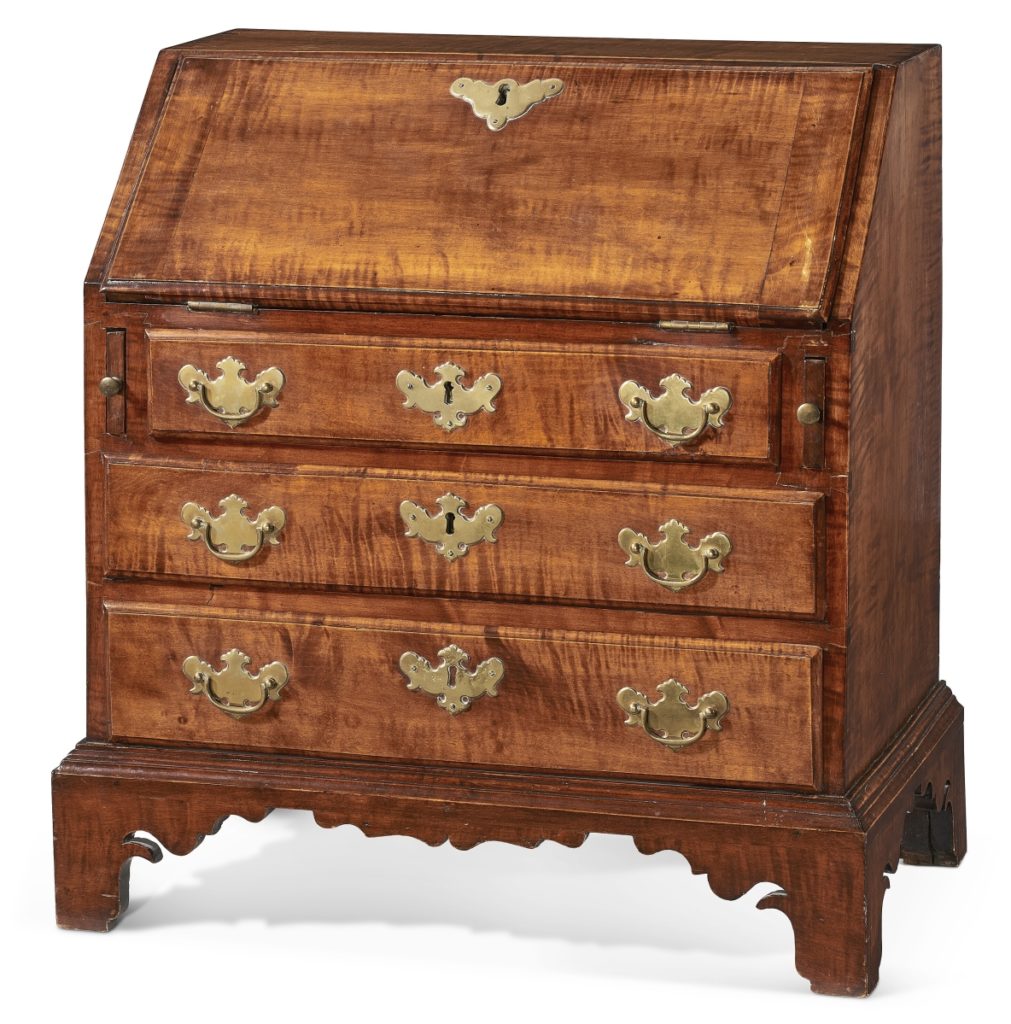
Chippendale figured-maple child’s slant-front desk, attributed to John Chipman (1746-1819), Salem, Mass., 1770-90, ex collection H. Richard Dietrich Jr, sold to Connecticut dealer Gary Sergeant for $126,000 ($25/45,000). Important Americana.
Topping Sergeant’s list was a Classical ebonized mahogany and ormolu-mounted “lighthouse” timepiece clock. Signed by Simon Willard and Son, Roxbury, Mass., and dating to 1823-28, the mechanism consigned by the Wunsch Americana Foundation went to Sergeant for $302,400 ($100/150,000). Massachusetts dealer Gary Sullivan, an authority on clocks, was an underbidder. According to Christie’s, the clock is one of two of this form with ebonized reeded cases, and one of five with a production number on its enameled dial.
Also bearing the Wunsch imprimatur was a pair of Chippendale carved mahogany side chairs. Attributed to Newport cabinetmaker John Townsend, the chairs, which belonged to Newport furniture authority Ralph E. Carpenter Jr from around 1955 until his death in 2009, went to Sergeant for $75,600. Sergeant paired his purchase with a circa 1750-70 Newport Queen Anne dressing table of rich plum-pudding mahogany, $60,480, noting, “We’ve been buying a lot of very good Newport and Boston furniture in the past couple of years. In my 50-year career, I don’t remember a better time to buy.”
There was vigorous competition on a 1770-90 Chippendale figured-maple child’s slant-front desk. Sargeant added the piece attributed to Salem, Mass., cabinetmaker John Chipman and once in the collection of the late H. Richard Dietrich Jr, to his tab for $126,000 ($25/45,000).
Bidding by phone, David Schorsch claimed some of the day’s best folk art. His purchases included Ammi Phillips’ circa 1839 oil on canvas portrait, $94,500 (30/50,000), of a young woman of the Haxtun family, a red book in her right hand, a stack of books under her left elbow. The Woodbury, Conn., dealer remarked, “It came directly from the family and was a lovely untouched, fresh picture. I think it was a good buy.”
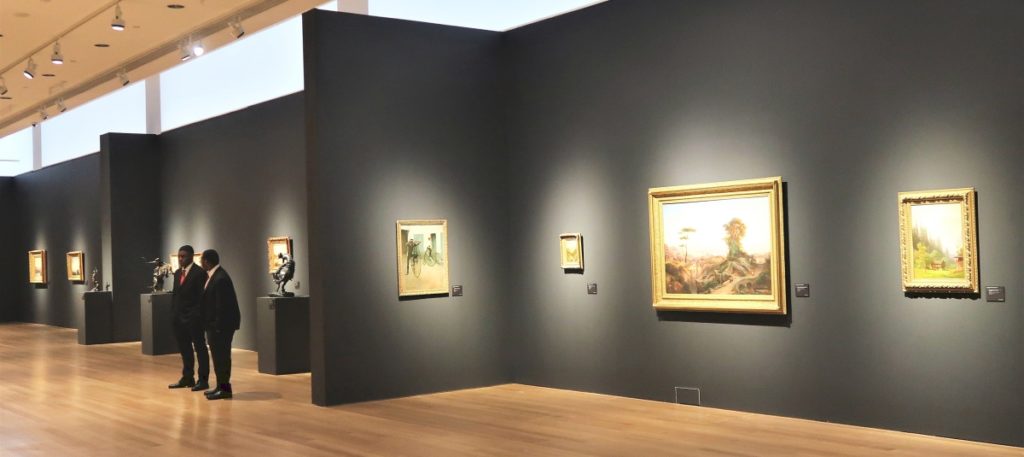
Galleries traditionally associated in January with American decorative arts were given over to “Nineteenth Century American Art,” sold January 19.
Schorsch also bought a spread-winged eagle with a 16½-inch wingspan. The carving attributed to Wilhelm Schimmel made $52,920 ($15/30,000). “I have a client who’s been looking for one and it sold on a phone call,” said the dealer, who also acquired folk paintings by Noah North, $18,900; Thomas Chambers, $8,190; and James Brown, $25,200.
Institutional buyers made astute purchases. Among them, a Queen Anne mahogany high chest of drawers, circa 1760-70, cataloged as from either Rhode Island or coastal Connecticut went to Alexandra Alevizatos Kirtley on behalf of the Philadelphia Museum of Art for $18,900. The museum’s Montgomery-Garvan curator of American Decorative Arts acknowledged, “I have admired that high chest since I first saw it in 2016 at Christie’s. PMA has a 1755 Newport high chest signed by Christopher Townsend and John Townsend. It’s a beloved tour de force. This high chest is fun and witty, from its extra (false) drawers in the pediment to its boot-carved feet.”
Other paintings of note in the session included “The Checkered House in 1717” by Anna Mary Robertson “Grandma” Moses, $151,200 ($80/120,000) and “Mary and Elizabeth Hathaway” by Sturtevant J. Hamblin, $113,400 ($100/150,000).
Leading Nineteenth Century furniture offerings was a circa 1820 Classical brass-mounted and rosewood-veneered marble-top pier table attributed to New York cabinetmaker Duncan Phyfe. A phone bidder claimed the table for $50,400 ($20/40,000).
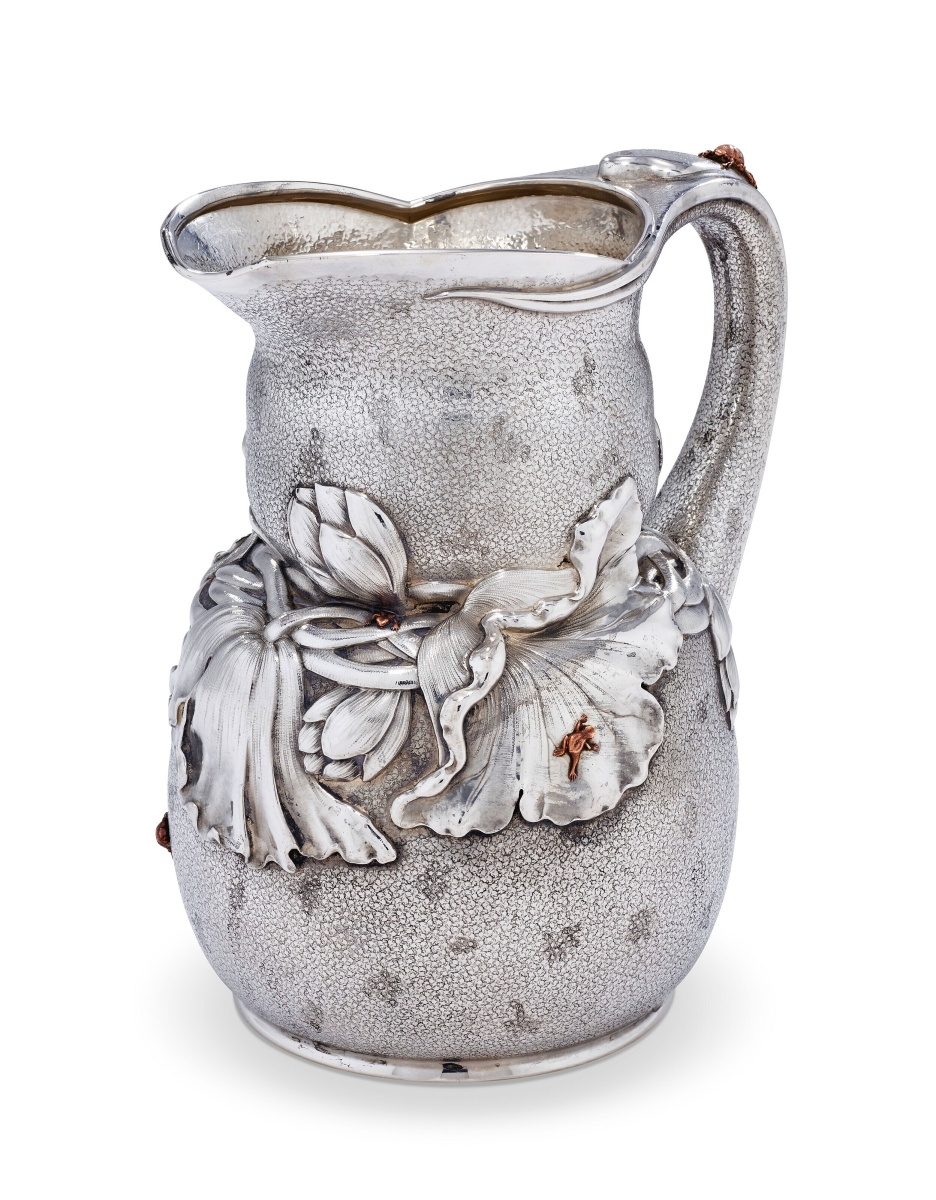
American silver and mixed-metal water pitcher, Tiffany & Co., New York, circa 1879, $50,400 ($10/15,000). Important Americana.
In lieu of a stand-alone sale, Christie’s folded a smattering of Chinese export art into its “Important Americana” session. Topping the selection was a pair of Eighteenth Century porcelain vases and covers, 49 inches tall and in the famille rose pattern, $100,800 ($100/150,000).
Chief among American silver lots was a mixed-metal Tiffany & Company water pitcher of circa 1879. Likely a 70th birthday present to William Ewart Gladstone, a British Liberal Party leader and four-term prime minister, it achieved $50,400 ($10/15,000).
Summing up Americana Week, Zimmerman said, “We brought together an important group of pieces in a wide range of categories, and the excellent results we saw were a testament to the quality of works offered, and robust competition from collectors. We were especially pleased to see vigorous bidding from institutions across the United States, which are clearly interested in expanding their Americana holdings.”
Online only, “Printed and Manuscript Americana & Science” continued through January 27 and is not included in this report.
Christie’s New York is at 20 Rockefeller Plaza. For information, www.christies.com or 212-636-2000.







.jpg)
.jpg)
.jpg)
.jpg)
.jpg)
.jpg)
.jpg)



.jpg)


.jpg)




.jpg)
.jpg)
.jpg)











